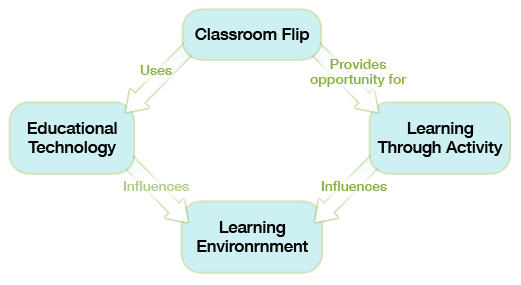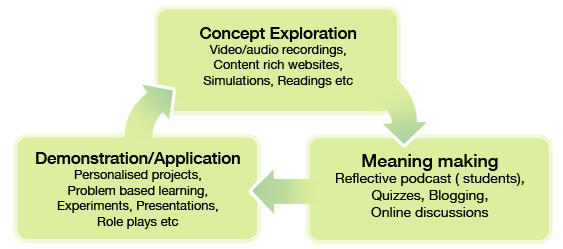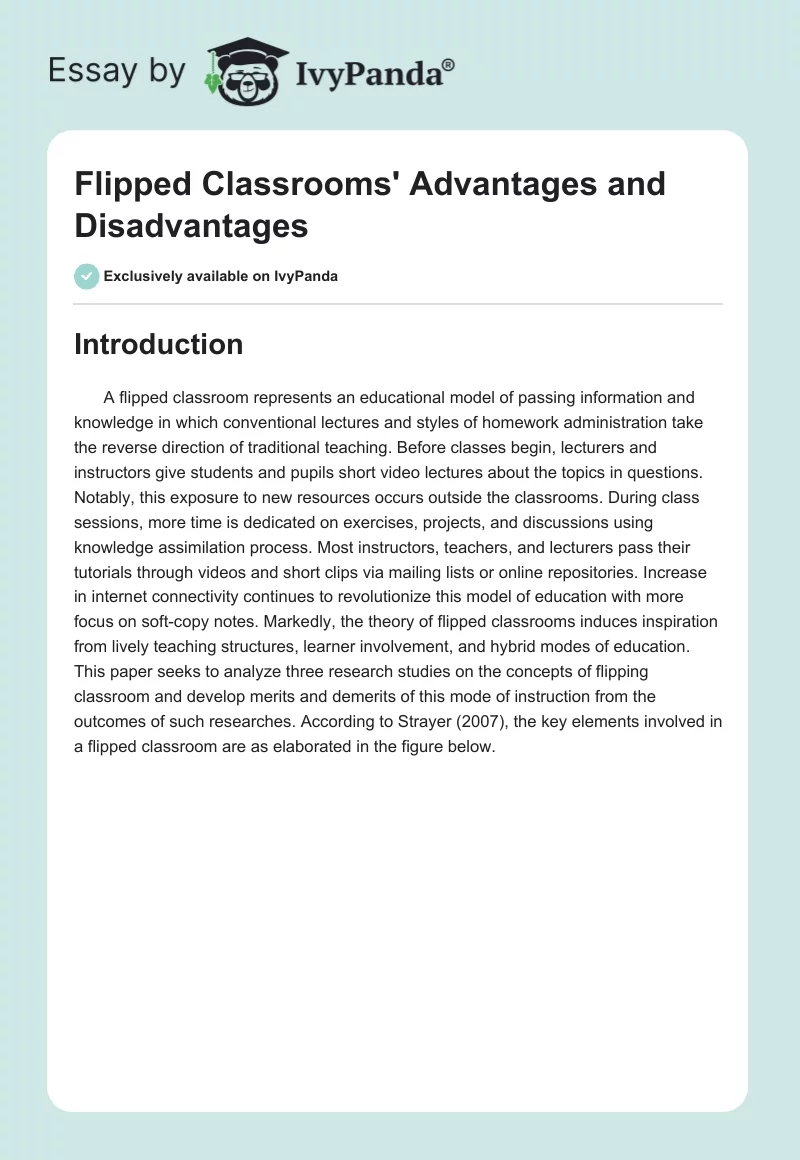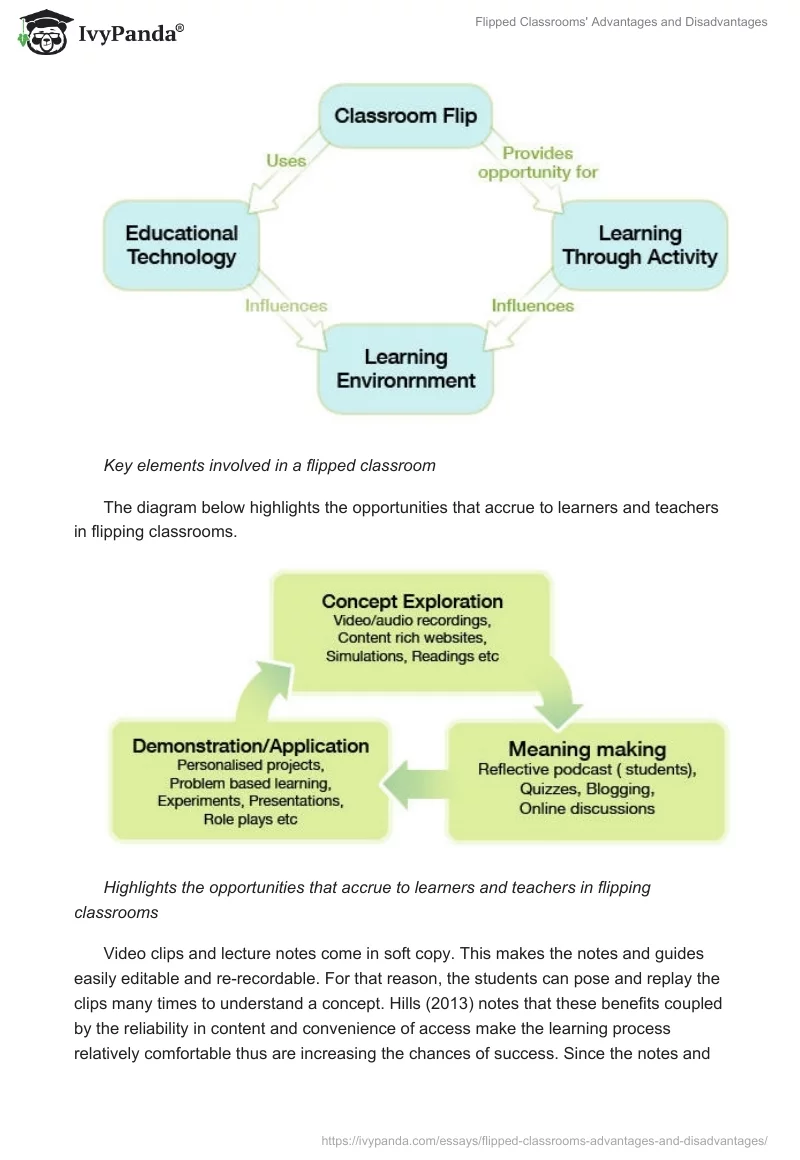Introduction
A flipped classroom represents an educational model of passing information and knowledge in which conventional lectures and styles of homework administration take the reverse direction of traditional teaching. Before classes begin, lecturers and instructors give students and pupils short video lectures about the topics in question. Notably, this exposure to new resources occurs outside the classroom.
During class sessions, more time is dedicated on exercises, projects, and discussions using knowledge assimilation process. Most instructors, teachers, and lecturers pass their tutorials through videos and short clips via mailing lists or online repositories. An increase in internet connectivity continues to revolutionize this model of education with more focus on soft-copy notes.
Markedly, the theory of flipped classrooms induces inspiration from lively teaching structures, learner involvement, and hybrid modes of education. This paper seeks to analyze three research studies on the concepts of flipping classrooms and develop merits and demerits of this mode of instruction from the outcomes of such research. According to Strayer (2007), the key elements involved in a flipped classroom are as elaborated in the figure below.

The diagram below highlights the opportunities that accrue to learners and teachers in flipping classrooms.

Video clips and lecture notes come in soft copy. This makes the notes and guides easily editable and re-recordable. For that reason, the students can pose and replay the clips many times to understand a concept. Hills (2013) notes that these benefits coupled by the reliability in content and convenience of access make the learning process relatively comfortable thus are increasing the chances of success.
Since the notes and questions arise on an online platform, lecturers and instructors can easily develop a matrix of frequently asked questions to assess areas that require improvement. Equally, lecturers and instructors have the opportunity to develop timelines based on areas that require strong emphasis. This helps in distributing time to the topics based on the demand among the students (Risku & Harding, 2013).
From an online platform, it is possible for the course departments to help students develop synthesis and explore such synthesis during the group discussions in class. Similarly, group discussions encourage teamwork in classroom contrary to traditional models that encourage individual homework. In a setting of group discussions and peer reviews, students learn and get ideas from their fellows, hence eliminating difficulties associated with individualized thinking in problem-solving situations (Bergmann & Sams, 2012).
Demerits of Flipped Classrooms
Excess Reliance on Student Motivation
The ability to pass knowledge at an individual base forms the basis of flipped classrooms. Even though this model does so by initiating individualized speed of learning, it highly depends on students’ intuitive drives (Hake, 1998). Notably, for this model to benefit learners, adequate self-motivation is mandatory. Since the level of motivation varies among students, this model of instruction impedes convenient learning among less motivated students.
Difficulty in keeping all the Students on the Same Subject
For effective learning, teachers assess individual students in relation to the performance of the class or group members. However, executing this task in a flipped classroom becomes an obstacle due to the individualized learning structures. Similarly, the relaxed nature of flipped classrooms enables students stay in different levels of their education even though movements in grade seem mandatory. The worst part of this demerit is that it results in a situation where all students in one class are at different levels, compelling the instructor to start lectures afresh
Difficulty in Testing
Instructors and lecturers administer tests and assessment examinations to a class of students at the same time to gauge how much each student was able to grasp during a specific period. In addition, the tests enable lecturers and teachers to evaluate the ability of each student and reference accordingly. In the event that students operate in a flipped classroom setting, they take examinations at different times, compromising of comparative evaluation. On the same note, tests and examinations administered at different times compel students to excessive procrastination and only resort to studies when examination times approach (Godwyn & Gittell, 2012).
Fluctuation in Internet Accessibility
Internet connectivity is a prerequisite for flipped classroom. For example, availability of Internet outside the classroom setting is mandatory for students and teachers to access notes (Aaronsohn, 2003). This implies that the method works only in areas with adequate internet connectivity. For this reason, students from the less fortunate members of the society and areas with unstable internet connectivity cannot use this model of education. This is a great setback to the adoption of a learner-centered system of learning in all regions.
Promotion of a Lazy Learning Environment
Even though human beings work under individual will circumstances, it is important to note that a relaxed system of education derails the level of urgency necessary for learning as Glover (2013) denotes. Flipped classroom encourages students to slow down their rates of engagement in classroom activities. Once students develop slow learning tendencies, their rate of knowledge intake goes down resulting in decrease in the amount of materials and skills learned within a period. In this aspect, teachers are also reduced to mere observers given the high rate of learners’ interaction with the learning materials.
Mode of Implementation
Even though no research has developed a comprehensive and universal mode of implementing this model, flipped classroom entails the administration of pre-recorded notes and clips to students. In class, discussions follow such notes with students enjoying the opportunity to develop solutions to the problems and concepts sent via online platforms.
The model gives students the opportunity to view a variety of lecture notes. Majority of lecturers and instructors using this model develop notes and clips running for an average of six minutes (Koch, 2013). During the interactive segments, students raise and pass questions to colleagues. As a of feedback analysis, instructors use the questions to gauge and test concept grasp levels among students. Equally, questions that fail to receive answers from students form the topic for class discussions.
In classroom discussions, some researchers lead and moderate the group discussions while others let students create, develop, and discuss solutions to the problems arising in concept grasps. In other settings, implantation of class discussion level of flipped classrooms entails development of ad hoc working groups that develop solutions to major problems within the course concepts.
Instructors in such settings suggest different methods of problem-solving, and, then, leave execution plans to the students. At this point, instructors’ roles are monitoring the progress and clarifying the contents developed from the ideas raised. Given the complexity of this model of instruction, several lecturers and instructors use it only on specific topics in order to ensure students stay together at all learning levels (Strobino, 2013).
Dr. Andrew Fairbairn’s Integrated Approach
Driven by the belief that traditional lecture tutorials fail in developing a formidable knowledge passage structure, Fairbairn undertook this study to explore the benefits of the flipped classroom in archeology. In his studies, Fairbairn argues that students need to engage in hands-on and practical designs in order to maximize knowledge acquisition. Additionally, he claims that key lecture contents need thorough practical analysis with students. Therefore, he developed a unique system of passing lecture topics and elements to his students.
Through an online platform, Fairbairn placed lecture notes and short video clips on focused topics. He aimed at targeting maximum utilization of students’ own times. Markedly, this platform encourages problem-based learning in which students developed different ways of handling classroom problems. In his execution of the model, Fairbairn believed that less formal instructional arrangements unlocked prospects for improved peer reviews, thus developing adequate identification, tackling of misunderstandings, and direct learning as evident in traditional educational models. He also maintained that students within the flipped classroom structures developed a close rapport with the instructors at higher levels than those in conventional learning models (Fairbairn, n.d.).
Integrated Approach to the Study
In order to develop a comprehensive conclusion on the topic, Fairbairn developed a systematic method of analyzing the outcomes of the different models of instructions. His study began with an intricate study of the traditional structures in educational institutions. Under this study, he developed a yardstick for success factors based on the interactional characters, test scores, behaviors, and overall social orientation of the students. In the second group of study, Fairbairn focused on students under the flipped classroom structures. A hybrid group of students using traditional and flipped classroom structures represented the third group of students under study (Fairbairn, n.d.).
Findings
Traditional Models
Traditional models of instruction also known as contact sessions often begin with a recap of the previous lectures. Free-form questions and answers follow the first session. After the questions and answers session, students form groups and engage in activities such as puzzles or games. This is to help analyze and deliberate on the main queries arising from the second level of the lectures. In this group, Fairbairn ensured change of roles among the students based on class contributions. This group developed great problem-solving skills. However, their styles of developing solutions depended on the teacher’s guide based on the previous lectures (Fairbairn, n.d.).
Flipped Classes
The second group under flipped classes engaged the lecturer on issues and problem-solving from individual opinions. Students get lectures and questions from an online platform then develop solutions to the problems. During the class sessions, instructors get different sets of ideas that students shoot in class discussions. The outcomes of this structure follow below.
Advantages
Appreciation
In this model of instruction, students acknowledge harboring chances to confirm their comprehension of the content both in formal and informal formative instructional undertakings. Developing a repository for instructional interaction between teachers and students provides the students with a platform to develop individual problem-solving skills. In many traditional educational models, such tendencies are absent given that teachers offer instructions before setting out tests and puzzles for students (Krueger, 2012).
High-test scores
The use of active learning models supports student-instructor engagements. For example, an increase in informal and formal interaction creates a beneficial relationship between instructors and students. The resulting multiplier effect of such an effective relationship is increased online interactive sessions. Increase in time dedicated to classwork under teacher guidance improves students’ critical thinking, discussion, and skills in solution development. Quality critical thinking and problem-solving skills translate to high test scores.
Flexibility
Flipped classroom models ensure flexible, active learning. Once students work under reliable and flexible circumstances, chances of missing lectures go down. Students easily juggle between classwork, homework, and co-curricular activities with the surety of complete lectures. This offers students more time to act on other non-academic activities, hence improving chances of talent development.
Proper Preparation
Use of online lecture notes and video clips to pass knowledge to students ensures proper and advanced preparation. Likewise, students under this model have the ability to prepare to take posted notes at their convenience. This contradicts the contact sessions that confine students to routine systems of classwork with predictable break times. In essence, adequate preparation from both parties ensures maximum use of the resources, hence increasing chances of success. Similarly, use of online models to align assignments and review group-based discussions enables increased levels of engagement, widening further the scope of knowledge acquisition.
Demerits
Time Consumption
Flipped classroom models require high investment in time and effort. In order to plan and design lectures and develop comprehensive online resources for every target groups, lecturers must dedicate adequate time and resources. Even though the material can last in the online platform for a lifetime, the time and dedication required to run and update an online database of lecture notes remains expensive.
Internet Connectivity
Several learning institutions lack internet connectivity. Similarly, not all students hail from homes with internet connectivity. Since online platform requires adequate internet connectivity, its employment in areas without such structures remains impossible. It is very difficult to implement a flipped model in areas and community occupied by the low-income populations. In order to institute a flipped classroom in areas with less technology, adequate resources are necessary (Godwyn & Gittell, 2012).
Flipped Classrooms Take Up Social Times
Even though many scholars argue that flipped classroom helps regulate the amount of homework students take home, it is vital to note that flipped assignments remain homework. For proper social development, students need adequate time to pursue personal interests, connect with family members and friends, as well as engage in play and other physical activities. However, flipped homework denies learners such opportunities. Many students remain glued to the internet following up on flipped homework. This deprives the students of adequate social and bonding time with family members and friends.
Hybrid Models
This model represents the problem associated with excessive academic work. Despite offering students opportunities to complement contact lessons with flipped classwork, the resultant effects of this model remain excessive learning, which harms knowledge intake. Students in this group exhibit character of excess bookwork. Playing and other physical activities had the minimal time allocation in this group of study. Fairbairn argues that this type of model encourages drilling.
Strayer Jeremy’s Comparison
As technological advancement continues to revolutionize the world, several sectors of the economy become affected. Education structures are some of the leading casualties with great advancements in instructional arrangements. Several instructors use technology in college and school classrooms, making flipped classrooms become the most trending model. In this model, Strayer (2007) argues that flip classrooms enable lecturers to explore systems outside the classroom structures to pass knowledge. In this research, he develops a comprehensive comparison between classroom flip and conventional contact instructional models.
In the flip classroom, Strayer uses an intelligent tutoring system to convey suitable concepts to his learners. In this system, learners developed lively learning activities that necessitated the use of computer spreadsheet suites to understand the study contents. In the conventional classroom, on the other hand, students enjoy contact lectures using slides on powerpoint presentations as well as lecture notes delivered in hard copies.
After contact classes, students in the conventional class models practiced their course concepts through assignment completions outside classrooms (Strayer, 2007). Even though there are great arrays of varieties in learning activities and arrangements in flipped classrooms, different styles of lecture presentation create a sense of unsettledness within students in this group. Equally, issues of comfortable learning remained questionable in the flip classrooms. Traditional learning structures failed to register any of the above problems (Strayer, 2007).
Pillars of Flipped Learning by Flipped Learning Network
In this study, a group of researchers from George Mason University sets out to explore the benefits and drivers of flipped learning. Even though this model remained relatively inactive in many parts of the world few decades ago, its use continues to gain ground in America’s elementary and post-secondary classrooms. The study articulates that the model uses video clips, power points presentations, and lecture notes to present guides and directions to students. Remarkably, it shifts learning structures from teacher-centered modes to student-driven models. This study used rigorous qualitative data available from the Colorado Schools to develop a matrix for evaluating drivers of the two different models of education (Strobino, 2013).
Flipped classroom allows high number of learning structures through liberalization of education designs. In this setting, instructors and teachers enjoy flexible abilities of rearranging learning space to accommodate lesson schemes and units within specified timeframes. This coupled with the ability to supervise group and individual work outputs simultaneously makes this model the most viable.
Strobino (2013) observes that in the conventional education model, teachers represent the main source of information; this is contrary to flipped classrooms. Once students receive notes and lectures from the online platform, they engage in individual evaluations. Such evaluations get in depth in classwork through the guidance of instructors during in focused group settings. From the student’s perspective and critical thinking skills, solutions to the course concept problems become achievable. The study findings, however, reiterate that flipped classrooms cannot eliminate the role of professional educators. This becomes evident in classroom discussions when lecturers and instructors moderate and guide student engagement. Therefore, the implication is that flipped classroom still relies on the traditional models of education to take center stage.
Conclusion
Despite the reliability that comes with the implementation of flipped classrooms, it is important to note that the demerits exceed the advantages. Proper measures are necessary to check the negative impacts associated with the implantation of flipped classrooms. Setting up adequate supervisory structures to control the students’ enjoyment of learning are necessary for checking any form of laxity.
Similarly, investment in internet infrastructure remains vital for the successful implementation of this model since developing a flipped classroom setting in an area with low or minimal internet connectivity exposes learning institutions to chances of failure. Therefore, it is important to stick to the traditional model of contact lessons. Conventional modes of instruction do not only increase the rate of interaction between lecturers and students but also create a setting for adequate interaction among students from different backgrounds, thus improving social development among the students.
References
Aaronsohn, E. (2003). The exceptional teacher: Transforming traditional teaching through thoughtful practice. San Francisco, CA: Jossey-Bass.
Bergmann, J. & Sams, A. (2012). Flip your classroom: Reach every student in every class every day. Washington, DC: International Society for Technology in Education.
Fairbairn, A. (n.d.). An integrated approach in designing and delivering courses using active learning pedagogies, engagement strategies, and technologies for the flipped classroom model. Sydney: University of Queensland Press.
Glover, R. (2013). Teaching politics beyond the book: Film, texts, and new media in the classroom. New York: Bloomsbury.
Godwyn, M., & Gittell, J. (2012). Sociology of organizations: Structures and relationships. Thousand Oaks: Pine Forge Press.
Hake, R.R. (1998). Interactive engagement vs. traditional methods: A six-thousand student survey of mechanics test data for introductory physics courses. American Journal of Physics, 66(1), 64–74.
Hills, C.A. (2013). The benefits of flipping classrooms. Web.
Koch, J. (2013). Teach 2. Belmont: Wadsworth.
Krueger, J. (2012). Five Reasons Against the Flipped Classroom. Web.
Risku, M., & Harding, L. (2013). Education for Tomorrow is a biocentric, student-focused model for reconstructing education. Rotterdam: Sense.
Strayer, J. (2007). The effects of the classroom flip on the learning environment: A comparison of learning activity in a traditional classroom and flip classroom that used an intelligent tutoring system. Ohio: Ohio State University Press.
Strobino, C. (2013). The effectiveness of flipping classroom instruction with homework assignments so as to increase student understanding of algebra. Bozeman, Montana: Montana State University Press.


